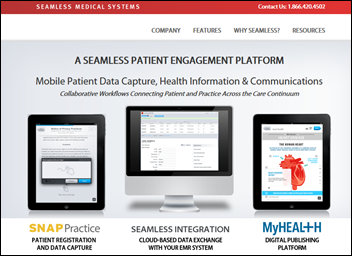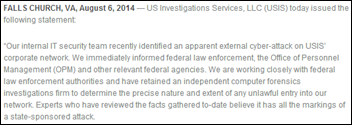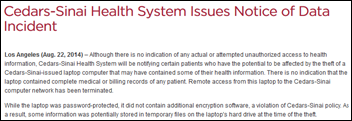Re: Dr Z. Great story, but whatever happened to professional courtesy???
Monday Morning Update 8/25/14
Top News
Todd Park will reportedly step down as US CTO but will remain a White House employee, moving back to the Silicon Valley to work on brokering relationships between technology companies and the federal government.
Reader Comments
From HIEway Robbery: “Re: HIEs holding registries hostage per Carl Dvorak’s testimony to ONC. Several CIOs have told me that HIEs have been allowed to use state-based immunization and public health registries to as a leverage point under Meaningful Use, forcing their health systems to join the HIE for up to several hundred thousand dollars.” Hospital IT people, please let me know if you’ve had such pressure applied. I promise to keep your details confidential, but I’d like to know the registry, state, and price quoted for HIE access. ONC needs to know that the generally noble idea of connecting to public health agencies as part of MU2 is being milked as a profit center by revenue-desperate HIEs if that’s the case. I’ve heard that one health system had to pay $700K to an HIE just to access the state’s immunization registry.
From Surveyor: “Re: Modern Healthcare’s top employers and Inc. 5000. These lists are a joke and your running the results is questionable.” I only mentioned in the Sponsor Updates which sponsors won. I don’t think the lists are a joke, but publications give awards to sell magazines and generate ad revenue, no different than those full-page airline magazine ads for “best steakhouses” or “best plastic surgeons.” Which means: don’t take them too seriously either as a reader or a winner. Let’s take a look at those two awards based on what I could find online. Readers with more information are welcome to chime in.
![]()
Modern Healthcare’s Best Places to Work
- Participation is free, but companies are offered a detailed employee feedback report that isn’t (the price, however, is modest).
- Information is self reported and not verified by the magazine.
- The survey asks for the voluntary employee turnover percentage, but it’s not clear how that number fits into the rankings even though it’s arguably the best way to assess employee satisfaction.
- A random number of company employees are surveyed directly using an adequate sample size from the entire employee database. The survey company was created specifically to conduct “Best Places to Work” programs across all industries and is a division of a publishing company.
- My grade of the methodology: B+. The employee survey portion seems sound and is of sufficient depth, but online survey of company programs and benefits is self reported and apparently unaudited (but the company HR people who respond aren’t likely to game the system to win). I’d like to see the voluntary turnover number reported in the profile of the winners. I think the winners are probably doing a good job in how they manage their employees, but it’s easy to forget that most companies don’t participate. It’s not quite perfect, but as good as can be expected from a voluntary survey type program designed to simultaneously stroke the egos of winners and the magazine.

Inc. 500/5000 list of fastest-growing private companies
- Information is self reported and not verified by the magazine.
- Companies send in 2013 gross revenue vs. 2010 gross revenue and basic demographic information only.
- Applicants have their short entry form signed by any CPA, financial analyst, or attorney. No proof of the claimed revenue numbers is required.
- Companies could be losing a ton of money and still make the list as long as their gross revenue increased in the previous three years. Privately held companies aren’t going to disclose profits, so the magazine has to go with revenue alone.
- Companies have to pay $150 to submit their information. The magazine pitches the exposure they’ll get as a result. They don’t indicate the number of applications received, but the 5,000 winners alone would generate 5,000 x $150 = $750,000 for very little work on Inc.’s part since they don’t verify the submitted information – they basically plug it into an Excel worksheet, sort by revenue growth percentage, filter by industry and a few other factors, and call it done.
- My grade of the methodology: F. The entire premise of the award – that revenue growth is the single best measure of company success – is suspect enough, but choosing winners from fee-based unaudited company submissions is lazy. Winners aren’t necessarily even the fastest growing companies – only the fastest growing of those that dash off the quick information form and mail in their $150. I wouldn’t dock a company points for trying to generate some easy PR in return for an investment of $150 and the five minutes it takes to complete the application form, but I also wouldn’t necessarily think more highly of the winners, especially noticing that some of the highly-ranked companies have only an employee or two. I like seeing fast-growing companies, but I wouldn’t buy shares of a publicly traded company’s stock based on a one-time snapshot of unaudited revenue growth.
From The PACS Designer: “Re: iPad vs. Android L. The iPad monopoly may start to start to shrink with the Android L, scheduled for release in late October with a true 64-bit system.” I would argue that the iPad doesn’t have a monopoly even now, representing less than a third of tablets sold in Q1 2014. Samsung is gaining ground quickly and Lenovo is coming on strong in the past year, although tablet sales seem to be hitting the wall anyway since there’s not much incentive for people to trade up.
HIStalk Announcements and Requests

Nearly two-thirds of poll respondents thing Cerner is getting a good deal in buying the Siemens healthcare IT business for $1.3 billion. New poll to your right or here, for health system IT employees: is your organization taking new security steps in reaction to the Community Health Systems breach? I would be interested in hearing more … click the Comments link after voting.
Listening: new from SOJA (Soldiers of Jah Army), an eight-piece DC-based reggae band. It’s not my favorite genre, but I like this since it sounds more like decent pop music instead of formulaic noodling by ganja-stupefied Rastafarians.
Last Week’s Most Interesting News
- Chinese hackers steal the data of 4.5 million Community Health Systems patients, most likely enabled by outdated network software as vendors responded slowly to address the Heartbleed exploit after it was announced in late spring.
- Oracle’s lawsuit against the state of Oregon says state officials should have hired a systems integrator to oversee the creation of its failed health insurance exchange, comparing Oregon’s project to an inexperienced company deciding to build a skyscraper without hiring an architect. The failed rollout of Healthcare.gov has been similarly attributed to CMS’s attempt to serve as its own project overseer.
- CMS statistics show that few providers (and thus few vendors) are clearing the Meaningful Use Stage 2 hurdle, with the early trend suggesting that practice-based users appear to be moving from smaller vendors to Epic, Cerner, athenahealth, eClinicalWorks, and Aprima.
- A New York Times article says CMS’s Medicare fraud prevention efforts are expensive and ineffective due to its poor management of private recovery audit contractors and the bogged down provider appeals process.
- The private equity owners of revenue cycle vendor TriZetto are rumored to be shopping the company at a price of $3 billion.
Webinars
August 27 (Wednesday) 1:00 p.m. ET. Enterprise Data – Tapping Your Most Critical Asset for Survival. Presented by Encore, A Quintiles Company. Presenters: Jonathan Velez, MD, FACEP, CMIO, Hartford Healthcare; Randy Thomas, Associate Partner, Encore, A Quintiles Company. This first of a webinar series called “It’s All About the Data” will describe the capabilities provider organizations need to become data driven. The presenters will provide an overview of the critical role of an enterprise data strategy, creating the right data from source systems beginning with implementation, real-world data governance, how to avoid “boiling the ocean” with an enterprise data warehouse, and the role of performance feedback to transform analytics insights into improved outcomes and efficiencies.
September 4 (Thursday) 2:00 p.m. ET. MU2 Veterans Speak Out: Implementing Direct Secure Messaging for Success. Presented by DataMotion. Moderator: Mr. HIStalk. Panelists: Darby Buroker, executive director of health information exchange, Steward Health Care; Anne Lara, EdD, RN, CIO, Union Hospital of Cecil County, MD; Andy Nieto, health IT strategist, DataMotion; Mat Osmanski, senior application analyst, Steward Health Care; Bill Winn, PhD, Meaningful Use service line executive, Navin, Haffty & Associates. Panelists will discuss the strategy and tactics of meeting the transitions of care requirements for MU2, including assembling the team, implementing Direct Secure Messaging, getting providers on board, and reporting results.
September 11 (Thursday) 1:00 p.m.ET. Electronic Health Record Divorce Rates on the Rise — The Four Factors that Predict Long-term Success. Presented by The Breakaway Group, A Xerox Company. Presenters: Heather Haugen, PhD, CEO and managing director, The Breakaway Group, A Xerox Company; Bill Rieger, CIO, Flagler Hospital, St. Augustine, FL. Many users are considering divorcing their EHR as dissatisfaction increases. Many are spending 90 percent of their time and resources on the wedding (the go-live) instead of the long-term commitment to new workflows, communication, education, and care outcomes (the marriage). Hear more about the findings of research published in “Beyond Implementation: A Prescription for Lasting EMR Adoption” about EHR adoption and success factors. Registrants get a free electronic or paper copy of the book.
Announcements and Implementations

The Albuquerque business paper profiles Seamless Medical Systems, which will release SNAP Express RX on Monday. It’s an iPad-based patient self-history system for pharmacies (vaccines, immunizations, and medications). The company also says its SNAP Practice check-in system will be piloted at Houston Methodist Hospital starting in October.
The state of Oregon finally files the lawsuit it has been threatening against Oracle, saying it paid Oracle $240 million to build the dysfunctional Cover Oregon health insurance exchange site. The Associated Press named the spectacular failure of Cover Oregon, which will be shut down, as the state’s top news story in 2013:
Once considered a national healthcare leader, Oregon produced the worst rollout in the nation of the new national health insurance program. While the crippled federal website eventually got up and walked, Oregon’s remained comatose, unable to enroll a single person online. The state had to resort to hiring 400 people to process paper applications. Officials lay much of the blame on the primary information technology contractor, Oracle Corp., and withheld some $20 million in payments. But state officials’ own actions played a role, too. In the face of disaster, they insisted on doing things The Oregon Way, clinging to a grandiose vision of creating a grand health IT system that would not only enroll new people in the national health insurance program, but also provide other vital services.
The personal information of 25,000 Homeland Security employees is compromised when hackers penetrate the systems of a federal contractor that performs security clearance. The contractor, USIS, says the cyberattack appears to be the work of an unnamed country’s government.
For-profit hospital operator Steward Health Care System (owned by a private equity firm) and The Boston Globe engage in legal wrangling over the hospital’s use of a patient’s medical records. The newspaper is running an in-depth feature about the man’s experience with the mental health system that Steward expects to be uncomplimentary to its hospitals, so it filed a lawsuit asking to be able to publicize the man’s records to tell its side of the story. The court said no. All of this happened before the article ran in Sunday morning’s paper and it appears that Steward’s heavy-handed actions were premature – the article touches little on the patient’s experiences at the chain’s Quincy Medical Center and Norwood Hospital and focuses more on the challenge of fitting mentally ill people into society so they can’t harm themselves and others.
Wired profiles Enlitic, a just-announced startup that will use deep learning algorithms to diagnose medical conditions. Data scientist founder Jeremy Howard says the company’s approach is different from that of IBM, which tries to teach Watson by feeding it textbooks that contain information that doctors already know vs. giving the computer raw data and letting it figure out the patterns that represent new knowledge. I’m not sure doctors need as much help diagnosing patients as computer people tend to think, but at least a small percentage of patient conditions are baffling.
Cedars-Sinai Medical Center (CA) reports exposure of the information of at least 500 patients following the theft of a laptop from an employee’s home. The hospital says the device was not encrypted per hospital policy because of an installation mistake. The description of the employee’s job suggests that he or she has IT responsibilities since it includes “troubleshooting software used for clinical laboratory reporting” and requiring off-hours availability.

A peer60 report on patient portals finds that the most implemented are from Cerner and Epic, while those most often being considered by the 10 percent of providers who don’t have one are Cerner, Medfusion, Meditech, Epic, eClinicalWorks, and Medhost. Generally deficient functionality includes meeting the needs of specialists, EHR integration, appointment scheduling, streamlined enrollment, bill pay, and managing the information of patients under 18. It concludes that health systems can hit the 10 percent engagement threshold required by Meaningful Use Stage 2.
Jonathan Bush’s 1990s business idea as described in his book finally happens: EMTs are providing primary care services in the home instead of just giving 911 callers expensive rides to the ED for non-emergent issues. It’s a smart idea: the supply of relatively easily trained EMTs and paramedics exceeds the available jobs (often in fire departments) and most people would prefer being evaluated and treated at home, especially if the EMR/paramedic was in touch with a doctor via telemedicine as needed.
A University of Pennsylvania Health System study finds that urinary catheters were removed more promptly (presumably reducing the chance of urinary tract infections) when EHR provider reminders were replaced with an integrated homegrown alert that required fewer clicks to generate the DC order.
Interesting: improved guidelines and more widespread use of less invasive surgical procedures have reduced blood transfusions by a third and blood profits by 70 percent in the last five years. The Red Cross takes in nearly $2 billion of its $3 billion annual budget from selling blood and employs 17,000 of its 26,500 employees in its blood program, requiring layoffs and expense cutting. People don’t realize that their thoughtful blood donations are sold to hospitals for hundreds of dollars per unit, sometimes by for-profit blood centers that don’t exactly broadcast that fact, one more aspect of healthcare that doesn’t seem like it should be a business but very much is one.
An investigation of the corporate support services department of Health and Hospitals Corporation of New York finds that officials contracted with friends and neighbors for no-work temporary jobs and hired unqualified but connected employees. In one case, a supervisor who was also a minister performed a wedding in his office during work hours.
The individual is no longer an employee of Memorial Hermann. We cannot disclose any further information.
— Memorial Hermann (@memorialhermann) August 20, 2014
Memorial Hermann Southeast (TX) fires an employee after someone complains to it about a racist comment she posted on her personal Facebook, on which she doesn’t identify herself as a hospital employee. The hospital announced the employee’s firing on Twitter, ironically. According to a legal analyst, “People have the right of free speech, but employers can fire you for whatever they want in the state of Texas.”
Contacts
Mr. H, Lorre, Jennifer, Dr. Jayne, Dr. Gregg, Lt. Dan, Dr. Travis.
More news: HIStalk Practice, HIStalk Connect.
Get HIStalk updates.
Contact us online.











Add to your ‘dubious’ awards list: Most Wired – in this day and age who wants to be “Most Wired”??; HIMSS EMR levels – just do one CPOE transaction and you’re up a level!
In this week of Emmy Awards, you should do a vote on the Most Ridiculous and Hollow HIT Award. Should make for some good laughs
700k to connect to an immunization registry? Disgusting. I should get to charge the HIE for each piece of my data it has the opportunity to share if that’s how they’re going to work things.
Mr. H – having your lawyer friend check on secondary use policies of these HIEs would be interesting too. Some of them require you allow them to “sell the data” or use it in ways that profit the HIE.
From first hand experience, I can tell you that the form we filled out for the Inc. 5000 list is not something that any CPA or attorney would sign without the numbers being accurate. Also, we asked if we could provide the company summary used in the magazine, and were told “no.” Inc. reviewed our website and other sources on their own and created their description of our company without any input from us.
As an employee from one on both lists, I can tell you this is a joke. Our CPA signed it because it means nothing…it is not a legally binding document. Watch how many of these “firms” have more huge layoffs this year…I’ll be sure to update when I see the news.
While I do have a problem with HIEs holding healthcare orgs hostage to access state registries – seriously, when will these HIEs ever develop a truly meaningful business plan? I have an even bigger problem with Epic’s president chiding these HIEs.
The dirty little secret with Epic: Epic charges extortion fees (industry leading transaction fees) to connect to other EHRs besides Epic. The reason is simply that Epic wants to make it so painful, that an HCO opts to force all providers onto Epic’s ambulatory solution rather than play nice in a heterogeneous EHR community.
Seems a bit hypocritical to me.
There are clinical networks that can get the data for much less. Surescripts and others have connections to state registries. HIEs are holding on doe dear life right now.
Ok if we are going to question the legitimacy of Best Place and Inc we should also question KLAS. Best of KLAS to some companies is joke because the do not show the sample size of who made best in KLAS. There should be a baseline measure, let’s say no less than 100 clients to even get a score with KLAS. The best award any company can get is repeat business from the client, and a referral from your client – Best in anything means nothing if it is just marketing.
John, you’re blowing smoke. Epic’s fees are pretty nominal when it comes to interoperability and you can buy it by the sip. Very, very small (few dimes) only one time per year to push your patient in sync with an HIE.
When you update your record it’s a somewhat more, but still very affordable and the value is definitely there, plus you only pay the fee once per year per patient who uses it.
Let’s talk about the CommonWell fees and John Hammergren’s excitement on the last McKesson / RelayHealth earnings call. He’s excited about “commercializing” CommonWell.
Add the vendor fees that CommonWell wants to charge in addition to the transaction fees and it will make Epic seems exceptionally cheap.
The question out there for everyone is – who should be forced to do interoperability for free, if anyone? And, if you suggest Epic program and maintain all this for free, why don’t you complain about CommonWell, RelayHealth, Cerner, all the HIEs, etc.
Why do you jump on Epic when they charge less than SureScripts? Less that NY’s various HIEs, etc?